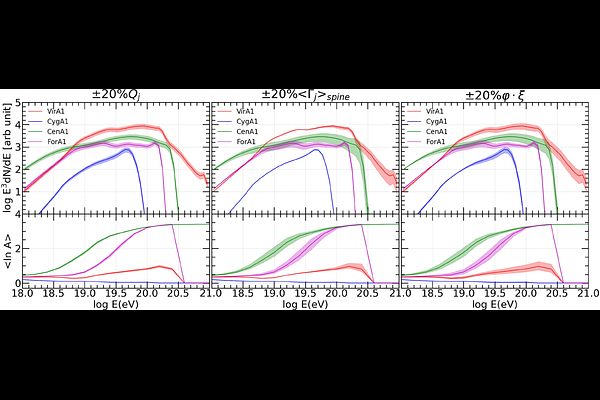Energy Spectrum and Mass Composition of Ultra-High-Energy Cosmic Rays Originating from Relativistic Jets of Nearby Radio Galaxies

Energy Spectrum and Mass Composition of Ultra-High-Energy Cosmic Rays Originating from Relativistic Jets of Nearby Radio Galaxies
Jeongbhin Seo Department of Physics, College of Natural Sciences, UNIST, Korea Los Alamos National Laboratory, Theoretical Division, USA, Dongsu Ryu Department of Physics, College of Natural Sciences, UNIST, Korea, Hyesung Kang Department of Earth Sciences, Pusan National University, Korea
AbstractRelativistic jets of radio galaxies (RGs) are possible sources of ultra-high-energy cosmic rays (UHECRs). Recent studies combining relativistic hydrodynamic simulations with Monte Carlo particle transport have demonstrated that UHECRs can be accelerated to energies beyond $10^{20}$ eV through shocks, turbulence, and relativistic shear in jet-induced flows of Fanaroff-Riley (FR) type RGs. The resulting time-asymptotic UHECR spectrum is well modeled by a double power law with an ``extended'' exponential cutoff, primarily shaped by relativistic shear acceleration. In this study, we adopt this novel source spectrum and simulate the propagation of UHECRs from nearby RGs using the CRPropa code. We focus on Virgo A, Centaurus A, Fornax A, and Cygnus A, expected to be the most prominent UHECR sources among RGs. We then analyze the energy spectrum and mass composition of UHECRs arriving at Earth. We find that, due to the extended high-energy tail in the source spectrum, UHECRs from Virgo A, which has a higher Lorentz factor, exhibit a higher flux at the highest energies and a lighter mass composition at Earth, compared to those from Centaurus A and Fornax A with lower Lorentz factors. Despite Cygnus A having an even higher Lorentz factor, the large distance limits its contribution. With a small number of nearby prominent RGs, our findings suggest that if RGs are the major sources of UHECRs, the energy spectrum and mass composition of observed UHECRs would exhibit hemispheric differences between the Northern and Southern skies at the highest energies.